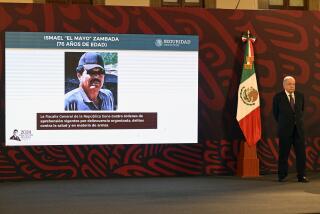Mexico failing to protect journalists, advocates say
MEXICO CITY — A highly touted system to protect Mexican reporters working in one of the world’s most dangerous countries for journalists is failing miserably and may in fact further imperil those it is intended to help, media advocates say.
In the first year of the administration of President Enrique Peña Nieto, killings of journalists declined significantly but other attacks multiplied, organizations that work on behalf of reporters said.
Article 19, an advocacy group, said 330 “aggressions” against journalists were reported in 2013, compared with 207 the year before. Those were defined as verbal or physical attacks, many occurring during protests when police countered forcefully, injuring journalists along with demonstrators. A little more than half were committed by public officials, said Dario Ramirez, director of Article 19.
More serious than that, however, is that the protections set up for journalists are not working, Article 19 and others said.
“I’d be better off in the hands of God,” said Mario Segura, a reporter who fled the violent state of Tamaulipas after surviving an abduction.
Under a law passed in mid-2012, journalists who believe they are in danger can avail themselves of a “mechanism” that is supposed to offer protections such as panic buttons, safe houses and bodyguards. Mexico received considerable kudos at the time for setting up the system. To date, 130 reporters have been accepted into the program; of those, only about one-third have received help, according to several journalists’ organizations.
They recount numerous, serious problems, including incompetent guards, flawed investigations and threat assessments, poor communication and faulty equipment. Four of the officials who run the mechanism have recently resigned or been fired, Article 19 said.
The same mechanism also applies to human rights defenders.
The government acknowledged that the system needed work.
Activists and consultants who late last week met with officials of the Interior Ministry, under whose authority the protection system is enforced, issued a statement saying all parties agreed to the “urgent” need to fix the problems within a short period and to “correct the delays.”
They were short on specific actions, however, and many journalists remain skeptical. Last month, some of those activists walked out of a meeting with Interior Ministry officials in protest.
“Mexican society and the international community think that because there is a mechanism, it’s working and people are safe,” said Anabel Hernandez, a prominent journalist and writer who has gotten bodyguards after several death threats. “But that is not the case. It has become a trap for journalists, a mortal trap.”
Hernandez said that despite the guards and other measures, gunmen recently broke into her Mexico City home and stole tapes from security cameras and other material. No one has been arrested.
A false sense of security from the government’s protection measures may enhance the risks, she and others said.
Segura said he has been given a panic button but not told whom to contact. “It’s a lie, a total lie,” he said. Protection “has actually gone backwards.”
Reporters Without Borders places Mexico at No. 152 on a ranking of freedom of expression in 180 countries, with No. 1, Finland, providing the best environment for news media. Several Mexican reporters have sought asylum in the United States (ranked No. 46) because of the dangers. Many have adopted a form of self-censorship, ceasing their reports on drug-trafficking, killings and other topics that local officials or criminals consider damaging.
More to Read
Sign up for Essential California
The most important California stories and recommendations in your inbox every morning.
You may occasionally receive promotional content from the Los Angeles Times.











